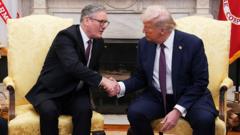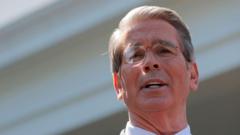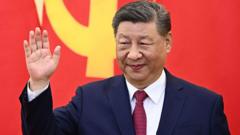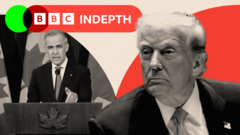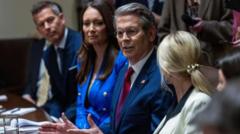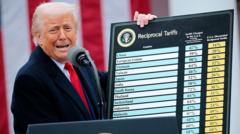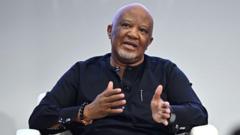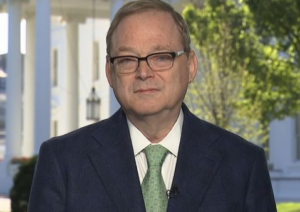The rise in U.S. Treasury yields due to recent tariffs suggests a potential economic tipping point, mirroring the consequences faced by the former British Prime Minister.
Tariff Turmoil: U.S. Yields Echo Liz Truss's Downfall

Tariff Turmoil: U.S. Yields Echo Liz Truss's Downfall
Market reactions to President Trump's new tariffs raise concerns reminiscent of the UK’s Liz Truss era.
April 9, 2025, 6:15 a.m. ET
In a concerning turn of events, the landscape of U.S. financial markets is echoing the chaotic aftermath of former British Prime Minister Liz Truss's tenure. Following President Trump's recent imposition of tariffs—some exceeding 100 percent on imports from China—yields on U.S. Treasuries have begun to escalate sharply, a situation that brings to mind the market turmoil triggered by Truss’s own economic missteps in 2022.
Truss, whose brief time in office lasted just 44 days, proposed sweeping tax cuts funded by extensive government borrowing, a move that ultimately led to a collapse in credibility and her resignation amid fears of a credit crisis as yields on British bonds soared. Now, as U.S. Treasury yields have risen to unprecedented levels—4.5 percent for the 10-year bond and over 5 percent for the 30-year bond—investors are showing signs of anxiety about the ramifications of Trump's tariffs.
Initially, after the president’s tariff announcement, there was a welcome retreat in bond yields despite a downturn in the stock market and a weakening dollar, suggesting temporary investor confidence. However, analysts now worry that this safe-haven status for American bonds may be fracturing, reminiscent of the sentiment during Truss’s administration where drastic market reactions compelled a policy reversal—something Trump has yet to consider.
The unfolding situation raises questions surrounding the Federal Reserve's role, which might have to take action similar to what the Bank of England did in 2022 to stabilize Britain's bond market. With limited political avenues to prompt Trump to retract his policies, market observers brace for a potentially volatile period ahead.
In these turbulent times, parallels between the leadership styles of Trump and Truss become increasingly pronounced, and the repercussions of their respective economic strategies loom large over the financial landscape.
In a concerning turn of events, the landscape of U.S. financial markets is echoing the chaotic aftermath of former British Prime Minister Liz Truss's tenure. Following President Trump's recent imposition of tariffs—some exceeding 100 percent on imports from China—yields on U.S. Treasuries have begun to escalate sharply, a situation that brings to mind the market turmoil triggered by Truss’s own economic missteps in 2022.
Truss, whose brief time in office lasted just 44 days, proposed sweeping tax cuts funded by extensive government borrowing, a move that ultimately led to a collapse in credibility and her resignation amid fears of a credit crisis as yields on British bonds soared. Now, as U.S. Treasury yields have risen to unprecedented levels—4.5 percent for the 10-year bond and over 5 percent for the 30-year bond—investors are showing signs of anxiety about the ramifications of Trump's tariffs.
Initially, after the president’s tariff announcement, there was a welcome retreat in bond yields despite a downturn in the stock market and a weakening dollar, suggesting temporary investor confidence. However, analysts now worry that this safe-haven status for American bonds may be fracturing, reminiscent of the sentiment during Truss’s administration where drastic market reactions compelled a policy reversal—something Trump has yet to consider.
The unfolding situation raises questions surrounding the Federal Reserve's role, which might have to take action similar to what the Bank of England did in 2022 to stabilize Britain's bond market. With limited political avenues to prompt Trump to retract his policies, market observers brace for a potentially volatile period ahead.
In these turbulent times, parallels between the leadership styles of Trump and Truss become increasingly pronounced, and the repercussions of their respective economic strategies loom large over the financial landscape.





